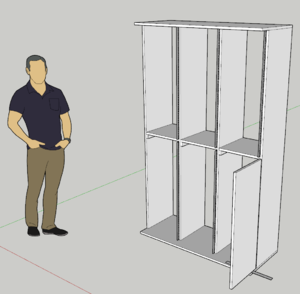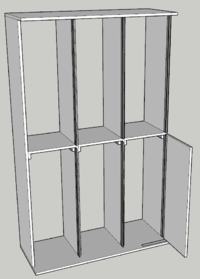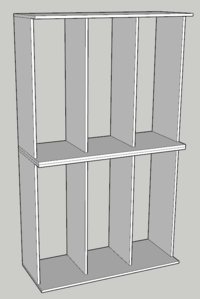Project:Lockers: Difference between revisions
From CoMakingSpace Wiki
explained approaches |
m →Horizontal Approach: wasted space - should be same height as other design |
||
| Line 38: | Line 38: | ||
con: | con: | ||
* more pieces to assemble | * more pieces to assemble | ||
* "double floor" requires more wood | * "double floor" requires more wood and wastes more space than cleats would | ||
<br clear=left> | <br clear=left> | ||
== Latch Hardware == | == Latch Hardware == | ||
Locking is possible by connecting the holes of a [[bracket]] and a matching piece of flat steel, e.g. with a padlock. Members can of course get creative and operate their locker with any number of over-engineered fancy setups ;-) | Locking is possible by connecting the holes of a [[bracket]] and a matching piece of flat steel, e.g. with a padlock. Members can of course get creative and operate their locker with any number of over-engineered fancy setups ;-) | ||
Revision as of 13:00, 20 September 2017
| ProjectInfoBox building lockers for our members | |
|---|---|

| |
| Status: | in progress |
| Release Date: | Oct 2017 |
| Initiator: | Lukas, Ciaran, Patrick, Mitja |
| Team: | Ed |
| Materials Used: | plywood ("Elliotis pine"), wood screws, piano hinges, brackets |
| Tools Used: | circular saw, table saw, smoothing plane, sandpaper, cordless drill |
| Software Used: | SketchUp |
We are building a bunch of lockers for our common room!
Vertical Approach

The first prototype consisted of six lockers arranged in a 3 × 2 pattern, all in one frame.
pro:
- few individual boards
- pretty close to the minimum amount of wood needed for lockers this size
con:
- large boards to handle
- large contraption, difficult to transport later on
- cleats holding the floors waste a bit of space
Horizontal Approach

Ciaran proposed an alternative design during the making of the first "vertical" prototype which will be the second one we try.
pro:
- smaller individual boards
- smaller units - easier to move to a new location one day
- no space lost with cleats
con:
- more pieces to assemble
- "double floor" requires more wood and wastes more space than cleats would
Latch Hardware
Locking is possible by connecting the holes of a bracket and a matching piece of flat steel, e.g. with a padlock. Members can of course get creative and operate their locker with any number of over-engineered fancy setups ;-)